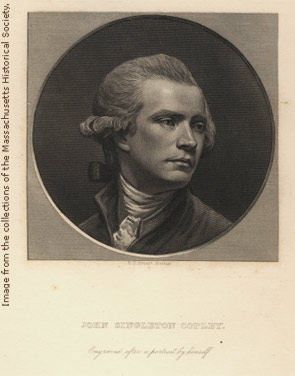![]() "John Singleton Copley."
"John Singleton Copley."
![]() Engraving by F.T. Stuart after the
Engraving by F.T. Stuart after the
![]() self-portrait by Copley, ca. 1776-1780.
self-portrait by Copley, ca. 1776-1780.
![]() Published in The Domestic and Artistic
Published in The Domestic and Artistic
![]() Life of John Singleton Copley, R.A.,
Life of John Singleton Copley, R.A.,
![]() Boston: Houghton, Mifflin and Company, 1882.
Boston: Houghton, Mifflin and Company, 1882.
![]() click image for more detail (large bandwidth)
click image for more detail (large bandwidth)
Born in Boston in 1738/9, John Singleton Copley expressed an interest in art at an early age. He began his formal artistic education in 1748 when his widowed mother married Boston engraver and artist Peter Pelham. He studied the work of fellow Boston artists John Smibert, Robert Feke, and John Greenwood, and learned basic art theory, composition, and painting by copying from prints and portraits in local collections. When Joseph Blackburn arrived in Boston in 1755, young Copley discovered the lighter Rococo style, which he quickly absorbed, then developing his own use of color and dramatic lighting. Copley soon emerged as the preeminent portrait painter in 18th-century New England. His roster of works includes many prominent Bostonians, including Joseph Warren, Mercy Otis Warren, John Hancock, Samuel Adams, and Paul Revere.
In 1774, Copley moved to England, where he would live for the rest of his life. While he continued to paint portraits, he concentrated increasingly on dramatic renderings of historical events. The most prominent among these was The Siege of Gibraltar (1791), commissioned by the City of London, depicting the British victory over the Spanish and French at Gibraltar in 1783. Copley spent five years on the painting, and the completed canvas measured 18 by 25 feet. At the time of his death in 1815, Copley's achievements were highly regarded in both England and the United States, and he had a clear impact in the fields of portraiture and history painting.
BACK
